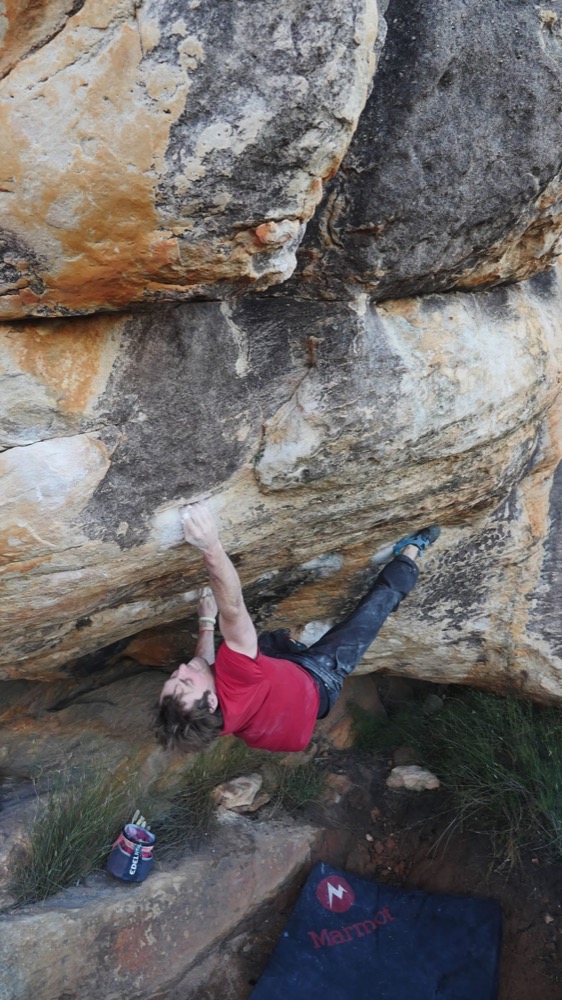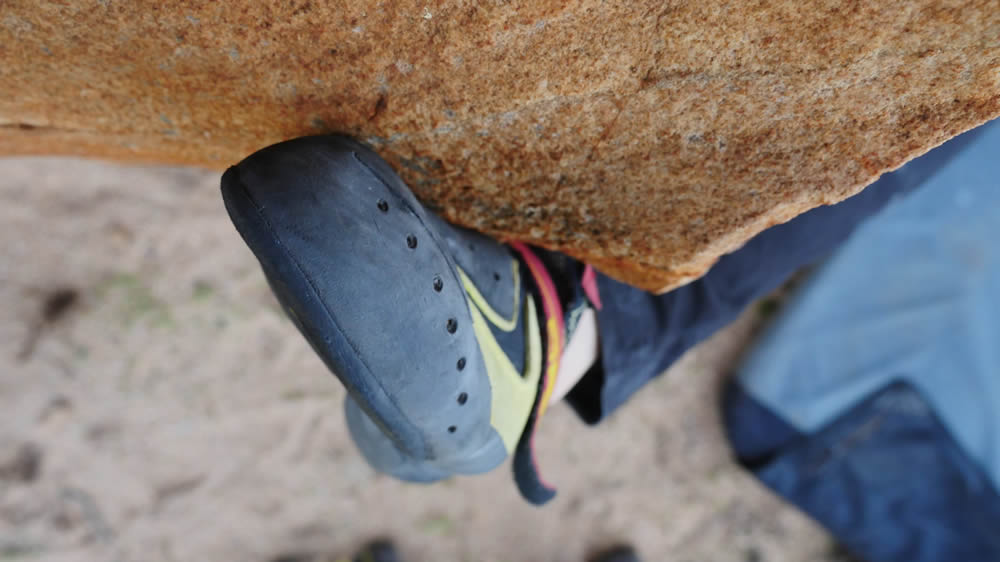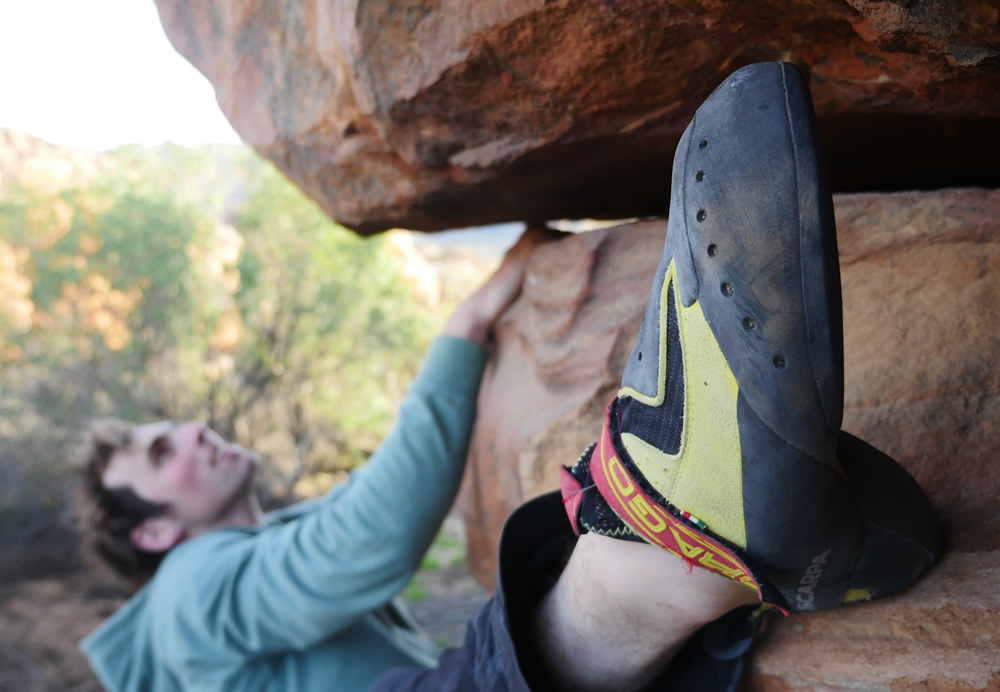Robbie Phillips takes a look at two of Scarpa's newest climbing shoes: the Drago and Chimera. They're soft, aimed at high-performance climbing, and have flashy colours! Read on to find out more...
I’ve always been a bit of a softy at heart, but it took a while to come round to softer climbing shoes. Weighing in at a meaty 80kg, I’m by no means a skinny sport climber, which makes good support through your feet really necessary for standing on small edges and crystals. There was a time when I’d happily have taken a plank of wood with some Vibram rubber plastered over the edge as my rock boot. Those days, however, are long gone, and since then I’ve seen the errors of my ways and have come round to the ever-seductive pleasures of the soft climbing shoe.
It all started on a sunny day in Northumberland. I was trying a 7C slab on the soft sandstone of Hepburn and I couldn’t get my Instinct-VS rock boots with their stiff Vibram EDGE rubber to stick to the smeary footholds. After having had a rant about the pointlessness of a softer rubber to one of the Scarpa designers earlier that day, I decided to crack out a pair of Chimera’s and see what they could do for me. They felt weird on my feet, like a sordid slippery rubber sock – it felt wrong, but I gave them their chance. After a few attempts on the climb I was still struggling to trust the lack of apparent support in my feet, but slowly I began to give more and more weight to the foot, relaxing and lowering my heel a little more every time, and before I knew it my feet were sticking to the smears like blu-tac!

Robbie boulding in Rocklands, wearing the Scarpa Drago on his left foot. This highlights how specific your footwear can be (or needs to be) for certain climbs.
Photo: Robbie Phillips Collection
What was this sorcery about soft shoes?
If you think about it, it does make complete sense. Softer rubber has more 'give' in it, allowing the rubber to mould over the smoother shapes and slight contours of a rocky smear. Of course my Instinct-VS were failing to smear, because they use a harder rubber and the sole is far less forgiving! The sudden realisation that I’d been using the wrong tool for years was both shocking and enlightening at the same time. Since then I’ve had more pairs of Chimera’s and Drago’s than my girlfriend has had hot dinners made by me… Which isn’t many, but that’s still quite a lot of climbing shoes!
Between the two pairs, I definitely prefer the Drago as it’s a Velcro shoe and therefore much easier to take on and off when bouldering and training indoors. This is primarily where I use it, as I like to have a more supportive shoe for sport and trad climbing. Saying that, I think if you’re a lighter climber (70kg and below) then maybe Drago’s will feel supportive enough for steeper sport climbing. I have used the Drago’s a lot for trad in Northumberland, where the sandstone responds really well to the softer rubber, and the routes aren’t long enough that I need to be wearing a more supportive shoe.
The one thing that both the Drago and Chimera do better than any shoe on earth is: toe hook! They have a super soft and super sticky layer of Vibram M-50 rubber wrapped around the toe. This stuff is like bubble gum on your foot and sticks to rock just as effectively! I’ve found that when climbing on anything where a toe is needed, be it a toe hook, a Heel-Toe, a Double-Toe-Hook or even a bat-hang, the Drago and Chimera outperform every shoe on the market!
I think you’ve got the picture now that I like both the Drago and the Chimera, but I do get asked a load of questions of whether these shoes are right for you, so hopefully these points below will help guide you:
If you’ve been climbing in Rental or Beginner shoes until now, you may find either of these a big step up in terms of “feel”, but they are actually very comfortable climbing shoes and if they fit, they are wonderful shoes for even relative newbies to the sport. I wouldn’t pick them as your first climbing shoe, but maybe your second or third? Don’t be afraid of the downturn nature of the shoe - they are very soft shoes and break in exceptionally well – your foot won’t be curved like that after wearing them!
If you’re an experienced climber but new to soft shoes (like I was), they will feel different, but hold out and learn to climb in them – you won’t be disappointed! A lot of climbers used to stiffer shoes have weak toes, so climbing in softer shoes can be very beneficial to strengthening them and to learn new ways of using your feet.
 Robbie toe-hooking in the Scarpa Drago. Photo: Robbie Phillips Collection
Robbie toe-hooking in the Scarpa Drago. Photo: Robbie Phillips Collection
If you’re a soft shoe aficionado, I don’t need to say anything more, get them!
If you climb indoors a lot then these are perfect!
If you climb on rock a lot then I would say they perform best on Sandstone, Gritstone and finer grained Granite – anything where smearing is in high supply! A brand new pair of Drago’s does actually edge quite well, but after heavy use over a couple of months they do get significantly softer. These are great shoes for kids and amazing for competition climbers – the soft rubber is ideal for volumes and slopers, and the Drago’s are in fact the most popular climbing shoe in the World Cup Circuit!
If you like laces then go for the Chimera, and if you like velcros then go for the Drago. Robbie using the Scarpa Drago. Photo: Robbie Phillips Collection
Robbie using the Scarpa Drago. Photo: Robbie Phillips Collection
If you want to know more about the technical design of the shoe, then have a read of my definitive Scarpa climbing articles:
https://www.scarpa.co.uk/blog/robbie-phillips-choosing-your-first-pair-of-climbing-shoes-guide/
https://www.scarpa.co.uk/blog/the-next-step-choosing-your-first-technical-pair-of-climbing-shoes/
https://www.scarpa.co.uk/blog/higher-education-becoming-the-climbing-shoe-guru/
Visit Robbie's Instagram and website.
Robbie is sponsored by Patagonia, Scarpa, Edelrid, EICA Ratho, Urban Uprising, Clif Bar and Friction Labs









